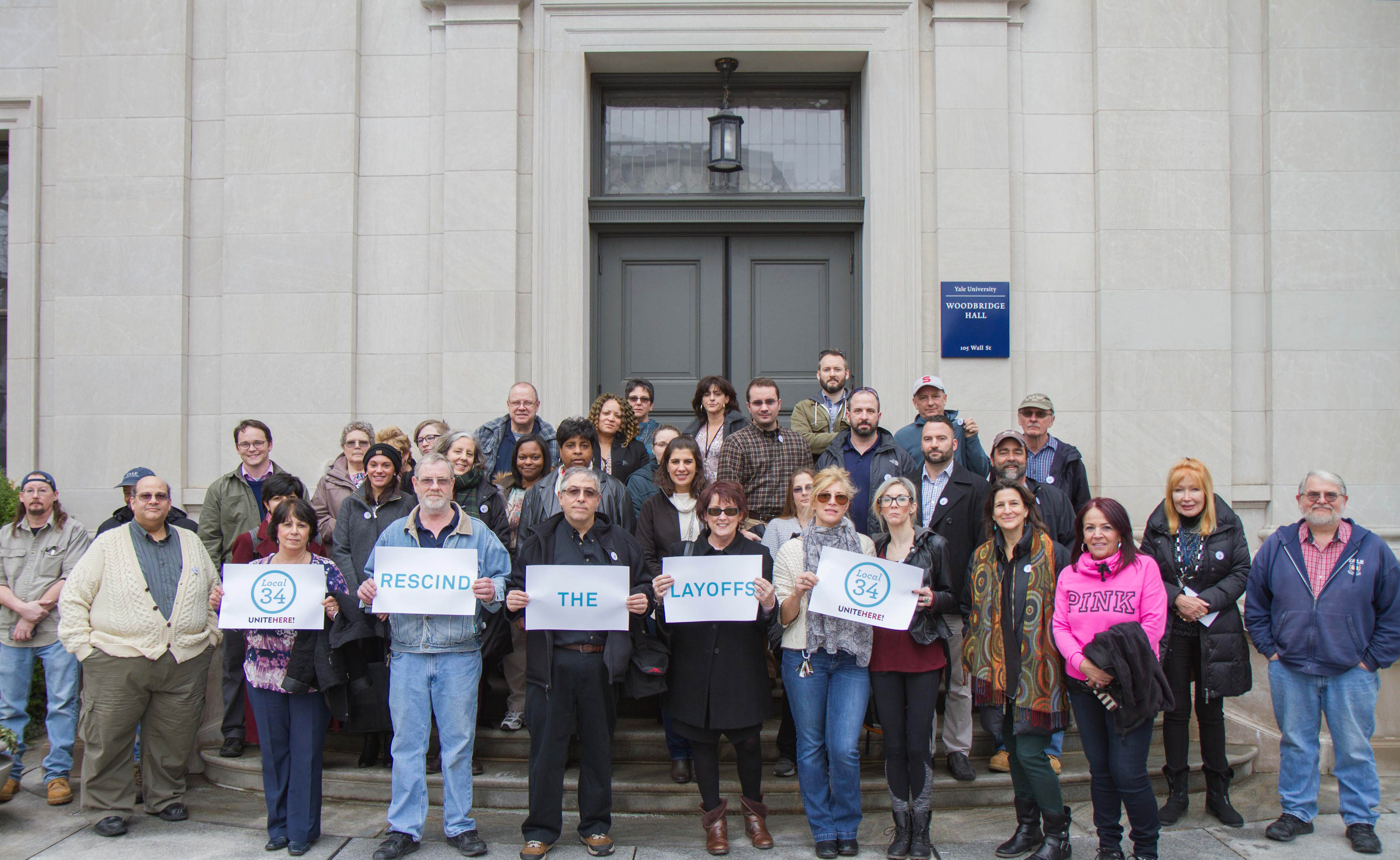
Courtesy of Local 34
Yale union members who were laid off last week petitioned University President Peter Salovey and Provost Ben Polak Monday afternoon to rescind the layoffs.
Several Local 34 leaders accompanied the 10 staff members from Yale’s Information Technology Services who learned on Jan. 24 that the University was laying them off as part of cost-cutting measures that have affected Yale’s administrative staff over the past few years. Neither the president nor the provost was in their offices when the union members arrived to deliver their identical letters of petition. Salovey’s office confirmed receiving the letter. Polak did not return request for comment.
“We … are outraged at the disrespectful treatment of us by ITS management and the University over budget problems,” read the letter, which was signed by members of Local 34, Yale’s clerical and technical workers union.
The letter called on Yale and ITS management to immediately rescind the layoff notices and halt further budget-reduction plans, as well as to engage the union in further meetings with its unionized employees. The letter also claimed that Yale had violated union contractual rights. Administrators denied that any misconduct had occurred.
The layoffs were announced in a Jan. 21 email to ITS staff from Chief Information Officer Len Peters. They were made in an effort to reduce the ITS deficit, which the letter said Yale has calculated at $7 million, although University spokesman Tom Conroy did not respond to requests to confirm the figure. The union letter questioned the necessity of making administrative cuts after the University announced a budget surplus of $196 million last year.
“Cutting administrative, financial and support staff or eliminating critical operational services is not the solution to the budgetary mistakes of the University and ITS senior management,” the letter continued.
Local 34 President Laurie Kennington said Monday that it is her impression that the decision to cut costs came directly from the provost, which in turn forced ITS management to make layoffs.
The layoffs may exacerbate tensions between Yale and its unions, only one year before the unions negotiate their contract with the University.
Vice President for Human Resources and Administration Michael Peel told the News Monday that there is very little historical precedent for Yale rescinding layoffs. Only in the case where something changes during the 90-day layoff notice period — a renewed research grant in the case of a researcher, or an unexpected turnover in a department which frees up a position — might Yale rescind a layoff, he said.
“Both of these sets of circumstances are rare, but do occur,” Peel said.
He added that, to the best of his knowledge, the contract between the unions and the University was followed properly.
But Kennington said Local 34 has succeeded in convincing Yale to rescind layoffs in the past, citing an instance in which the University recently rescinded eight layoffs in Patient Financial Services.
“We expect them to rescind [the layoffs] — especially if Yale wants to maintain labor peace in this contract year,” Kennington said. “It’s a matter of whether management is committed to the employees in the department.”
Peel characterized layoffs as an annual part of managing the University’s expenditures. There have been layoffs even in years in which Yale has had an “abundance of resources,” he said. Although Yale attempts to keep layoffs at a minimum, Peel said, the University lets around 2 or 3 percent of its administrative staff go each year in order to offset new hires.
“Our employment needs are constantly changing,” he said. “When we have tighter budgets and have to reduce costs, work is prioritized — with some eliminated or done in a less costly way.”
In an interview with the News last week, Kennington called the layoffs of the 24 ITS employees “an unacceptable way for the biggest employer in town to save money.” Kennington also said that job security for union members will be a priority next year during contract negotiations.
Overall, the number of Yale’s clerical and technical workers — who are represented by the two University unions Locals 34 and 35 — has been increasing, not decreasing, Peel added. One figure shows that in 2009, following the financial crisis that slashed the endowment by a quarter, Yale had 3,406 clerical and technical staff. Now, Peel said that number has risen to 3,617: a jump of 207 workers.
But the picture may not be altogether bleak for the laid-off workers, as Peel pointed out that when a clerical or technical staff member is laid off, he or she does not leave the University but instead is placed in an internal Interim Employment Pool. These workers have 22 months — a period in which they receive full pay and benefits — in which to find another position at Yale.
Most of the clerical and technical workers in the “pool” do eventually find other jobs at the University, Peel said. If the employee takes a lower-rated job from the pool, they still receive the same rate of pay they got at their previous job.
“While a clerical and technical staff member may have preferred the job from which they were laid off, there is no economic impact,” Peel added.
Kennington said the layoff pool was only created after years of pressure from Local 34. And last year, Kennington said, Peel threatened to cut the layoff pool, though Peel disputed that claim.
ITS employee Jo-Ann Dziuba described a disconnect between administrative decision-makers and ITS staff.
“There is no conversation with senior management,” Dziuba said, adding that the 10 employees who were laid off were “the meat of the department.”
The size of Yale’s administrative staff currently numbers 9,490.







